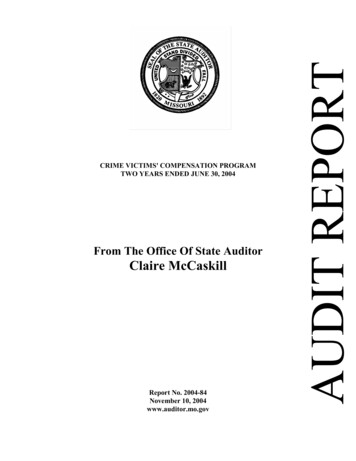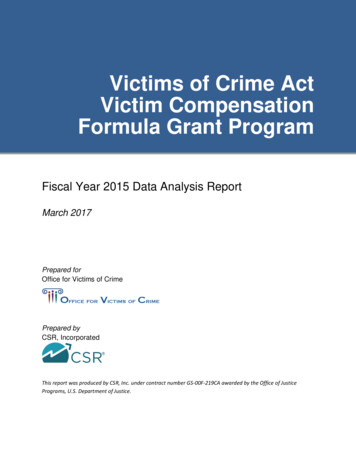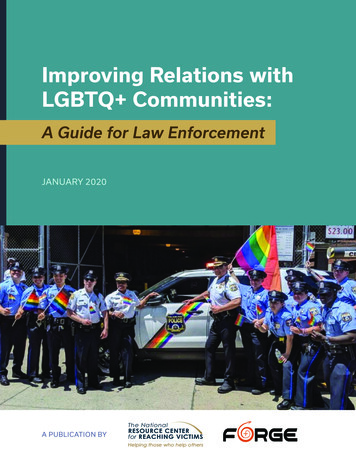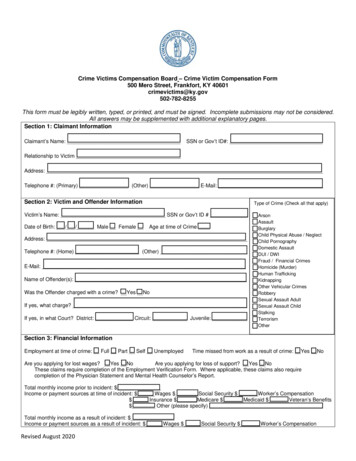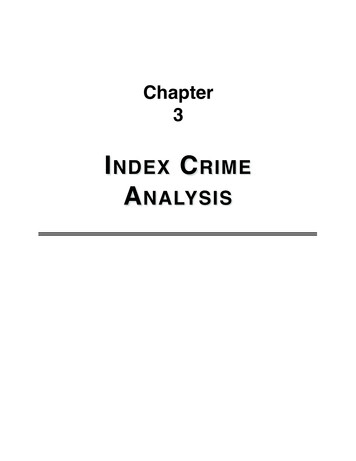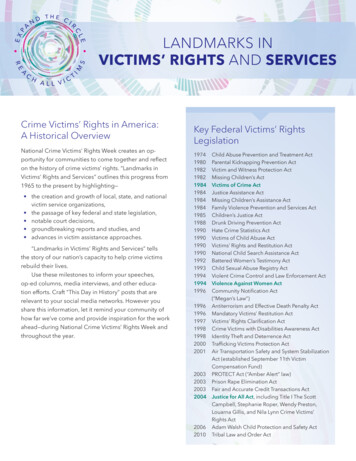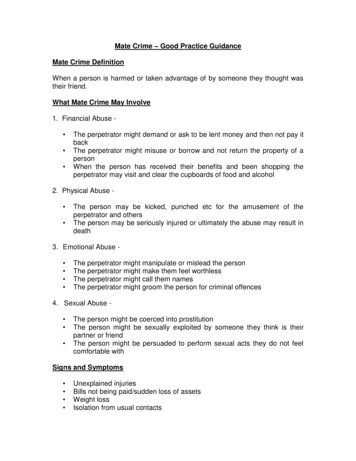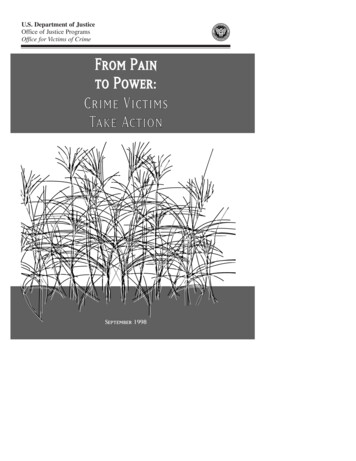
Transcription
U.S. Department of JusticeOffice of Justice ProgramsOffice for Victims of CrimeFrom Painto Power:Crime VictimsTa k e Ac t i o nSeptember 1998
U.S. Department of JusticeOffice of Justice Programs810 Seventh Street, N.W.Washington, D.C. 20531Janet RenoAttorney GeneralRaymond C. FisherAssociate Attorney GeneralLaurie RobinsonAssistant Attorney GeneralNoël BrennanDeputy Assistant Attorney GeneralKathryn M. TurmanActing Director, Office for Victims of CrimeOffice of Justice ProgramsWorld Wide Web Homepage:http://www.ojp.usdoj.govOffice for Victims of CrimeWorld Wide Web Homepage:http://www.ojp.usdoj.gov/ovc/For grant and funding information, contact:Department of Justice Response Center1–800– 421– 6770This document was prepared by Victim Services, supported bygrant number 96-VF-6X-K0008, awarded by the Office for Victims of Crime,U.S. Department of Justice. The opinions, findings, and conclusions orrecommendations expressed in this document are those of the author(s) anddo not necessarily represent the official position or policies of theU.S. Department of Justice.The Office for Victims of Crime is a component of the Office of Justice Programs whichalso includes the Bureau of Justice Assistance, Bureau of Justice Statistics, the NationalInstitute of Justice, and the Office of Juvenile Justice and Delinquency Prevention.
From Painto Power:Crime VictimsTa k e Ac t i o nSeptember 1998
AcknowledgmentsThe Office for Victims of Crime (OVC) would like to thank VictimServices for their hard work in the development and writing of thisdocument. Specifically, OVC would like to acknowledge the followingindividuals for their dedication and time in producing this publication.Lucy N. Friedman, Ph.D.Executive DirectorVictim Services2 Lafayette Street, 3rd FloorNew York, New York 10007( 212) 577–7705Since 1978, Dr. Friedman has served as the Executive and FoundingDirector of Victim Services, the largest victim assistance provider inthe nation. Dr. Friedman has worked to incorporate victim servicesinto all system components that come into contact with victims—including schools, hospitals, and the courts. Among her innovationsare a domestic violence program that teams police officers withcounselors to reach domestic violence victims; New York City’sfirst school-based mediation program, which teaches young peoplenon-violent conflict resolution; the country’s first domestic violenceservice program in a public housing setting; and a counseling programfor families of homicide victims. Dr. Friedman is a 1994 recipient ofthe President’s Crime Victim Service Award.
Susan B. Tucker, J.D.Director of Policy and Research DevelopmentVictim ServicesSusan B. Tucker is Director of Policy and Research Developmentat Victim Services, where she has directed projects on the costsof domestic violence, anti-bias education for immigrants in ESOLprograms and crime victim activism. She has written and spoken ona variety of victimization and violence prevention issues includingdomestic violence, workplace domestic violence and victim assistance. She previously taught and practiced law in New York City.Peter NevilleProgram AssistantVictim ServicesPeter Neville is Program Assistant in the Policy Office at VictimServices, where he works on a broad range of crime, victimizationand violence prevention topics. Previously, he worked at the BushCenter in Child Development and Social Policy at Yale University,focusing on public policy in the areas of early education and familyservices. He holds a B.A. in psychology from Wesleyan University.
ForewordAcross America, victims of crime have turned their agony intoactivism. Many have found that participating in community service—helping other victims and initiating crime prevention and awarenessprograms—contributes significantly to their own healing. Thesevictims include extraordinary people such as Marilyn Smith, whofounded a comprehensive victim service program in Seattle for deafand deaf-blind victims of sexual assault after trying unsuccessfullyto find services herself as a deaf sexual assault victim; Azim Khamisa,who joined with the grandfather of the 14 year-old gang member whomurdered his son to provide gang prevention programs in San Diegoschools; and the many parents who came together after their childrenwere killed by drunk drivers to support Mothers Against Drunk Drivingin its successful efforts to strengthen laws, provide victim impactclasses, and educate the public about the devastating impact ofthis crime.This monograph chronicles ways in which many crime victimsare channeling their pain into helping others, improving theircommunities, and healing themselves at the same time. It describesopportunities for victims who want to become active and makesimportant recommendations for victim service programs regardingways to involve victims in community service.The monograph was written by Victim Services, a New York City-basedprogram which is the largest victim assistance provider in the nation.The monograph is part of a larger document entitled New DirectionsFrom the Field: Victims’ Rights and Services for the 21st Century, acomprehensive report and set of recommendations on victims’ rightsand services from and concerning virtually every community involvedwith crime victims across the nation.
Crime victims themselves have a critical role to play in the nation’sresponse to violence and victimization. The purpose of this monograph is to foster increased collaboration between victims, serviceproviders, and policy makers to ensure justice and healing for allvictims of crime.Kathryn M. TurmanActing DirectorOffice for Victims of Crime
“Pain falls drop by drop upon the heart until, in our owndespair, against our will, comes wisdom.”—Agamemnon, Aeschylus
Table of ContentsIntroduction: Two Stories . . . . . . . . . . . . . . . . . . . . . . . . . . . . . . . . . . .1The Trauma of Violence Leaves Its Mark . . . . . . . . . . . . . . . . . . . . . . . .3Community Involvement Since the 1982 Task Force Report . . . . . . . . .7The Impact of Crime . . . . . . . . . . . . . . . . . . . . . . . . . . . . . . . . . . . . . . .9Benefits of Community Involvement . . . . . . . . . . . . . . . . . . . . . . . . . .11Rebuilding Low Self-Esteem . . . . . . . . . . . . . . . . . . . . . . . . . . . . . .11Reducing Isolation . . . . . . . . . . . . . . . . . . . . . . . . . . . . . . . . . . . .12Regaining a Sense of Power . . . . . . . . . . . . . . . . . . . . . . . . . . . . .13Dealing with Fear and Anger . . . . . . . . . . . . . . . . . . . . . . . . . . . . .13Examples of Community Involvement . . . . . . . . . . . . . . . . . . . . . . . . .16Victim Assistance . . . . . . . . . . . . . . . . . . . . . . . . . . . . . . . . . . . . .16Victims’ Rights Advocacy . . . . . . . . . . . . . . . . . . . . . . . . . . . . . . .16Violence Prevention . . . . . . . . . . . . . . . . . . . . . . . . . . . . . . . . . . .17Caveats Regarding Victim Activism . . . . . . . . . . . . . . . . . . . . . . . . . . .19Barriers to Involvement . . . . . . . . . . . . . . . . . . . . . . . . . . . . . . . . . . .22Victim Activism Recommendations . . . . . . . . . . . . . . . . . . . . . . . . . . .25Recommendations for Victim Service Programs . . . . . . . . . . . . . .25Recommendations for Government . . . . . . . . . . . . . . . . . . . . . . .26Conclusion . . . . . . . . . . . . . . . . . . . . . . . . . . . . . . . . . . . . . . . . . . . . .29Appendix: Victim Involvement in Action . . . . . . . . . . . . . . . . . . . . . .31Mothers Against Drunk Driving (MADD) . . . . . . . . . . . . . . . . . . . .31Parents of Murdered Children (POMC) . . . . . . . . . . . . . . . . . . . . .32P.O.W.E.R. (People Opening the World’s Eyes to Reality) . . . . . . .33Remove Intoxicated Drivers (RID) . . . . . . . . . . . . . . . . . . . . . . . .34
The Stephanie Roper Committee and Foundation . . . . . . . . . . . .35Teens on Target (TNT) . . . . . . . . . . . . . . . . . . . . . . . . . . . . . . . . .36Youth Empowerment Association . . . . . . . . . . . . . . . . . . . . . . . . .37Endnotes . . . . . . . . . . . . . . . . . . . . . . . . . . . . . . . . . . . . . . . . . . . . . . .41References . . . . . . . . . . . . . . . . . . . . . . . . . . . . . . . . . . . . . . . . . . . . .45
Introduction: Two StoriesIn 1985, Ralph Hubbard’s 23-year-old son was shot and killed inNew York City. After years of feeling angry, frustrated and powerless,Hubbard resolved to help other families work through their suffering.In a Victim Services support group for families of homicide victimsin New York, he began to speak out, telling his family’s story to thepolice, criminal justice officials, social service providers, and thepublic. He found that telling others what his family had gone throughhelped him cope with his pain and anger and inspired other victimsto address their feelings. He started a self-help group for men whohad lost family members to violence. He also became an adviserto New York’s Crime Victims’ Board, vice president of Justice ForAll, a victims’ rights advocacy group, and a board member of theNational Organization for Victim Assistance. A leading spokespersonfor victims’ rights in New York State, Hubbard feels no less compelledto be an advocate for victims ten years after his son’s murder:“It’s something I need to do. This is therapeutic for me.”Survivors from the 1993 Long Island Railroad massacre weredetermined to prevent similar atrocities from happening to others.Colin Ferguson’s shooting spree transformed a number of thosewho were either on the train or lost family members into outspokenadvocates for gun control and victims’ rights. Today, they speak atvigils, rallies, on television talk shows, and with legislators about theCrime Victims Take Action1
personal impact of the event, and they lobby for a ban on assaultweapons, including the model used in the shooting. Tom McDermott,who was on the train that evening, believes he was spared in order tojoin the fight against gun violence. “I’m a radical now,” he often says.“I’m a radical for the safety of us all.”12From Pain to Power
The Trauma of Violence Leaves Its MarkLong after the physical wounds have healed, many crime victims continue to feel overwhelmed by the psychic pain of loss, powerlessness,low self-esteem, isolation, fear, rage–feelings that often are shared bytheir family and friends, as well as by the extended community.From the ashes of criminal violence, victims and their families arestruggling to rebuild their communities, as well as their own lives.Through community activism, individuals like Ralph Hubbard andTom McDermott are transforming their pain into power, helpingchange society, and healing themselves in the process. Moving fromthe personal to the political, they work to correct causes of crime thatare systemic, such as poverty, racism, sexism, the culture of violenceand easy access to guns; to hold those who commit crimes accountable; and to enact victim-sensitive reforms and programs. As thecrime victims’ movement enters its third decade, advocates shouldlook for ways to nurture victims’ desires to help others by providingeducational and organizational opportunities for community action.Without intervention, victims can become chronically dysfunctional—afraid to venture out at night, unable to work productively, alienatedfrom neighbors and friends, distrustful of police and courts, andoverly dependent on social services. Their withdrawal from life hurtstheir families and weakens the fabric of the community.Crime Victims Take Action3
Individual counseling and practical assistance help people dealwith the psychological aftermath of crime and reconstruct a senseof equilibrium. When crime victims move from their personal experiences to a broader social analysis and to activism, they can also aidtheir own recovery from the trauma of victimization. Recognizing oraddressing the social conditions that lead to violence and victimization is important. Helping other victims, working to change laws,or mobilizing violence prevention initiatives can help victims andsurvivors regain a sense of control and channel their fear and rageinto efforts for reform.The history of grass roots efforts in other movements shows thatcommunity activism can be a powerful catalyst for social change.Individual stakeholders—those whose lives were directly affectedby the movement’s cause—have brought about landmark reforms.The movements for civil rights, elder rights, welfare, environmentalprotection, and AIDS research and treatment have been spearheadedby those directly affected by the issues. Like crime victim activism,each of these movements arose from victimizing conditions of neglect,persecution, or marginalization; and the involvement of “victimized”individuals legitimized the cause.A crucial step toward activism may be the individual’s selfidentification as a member of a group victimized by particular socialconditions. Yet within the crime victims’ and battered women’smovements, the “victim” label remains controversial. Some believe itis a stigmatizing label that hinders recovery and reinforces society’sperception of victims as helpless, hopeless, and dependent. Otherssee it as an empowering identification that promotes connection withothers and spurs community involvement.4From Pain to Power
As Crenshaw points out, “[I]dentity-based politics has been asource of strength, community and intellectual development [formany individuals and groups], African-Americans, other people ofcolor, and gays and lesbians, among others.”2 The individual’s selfidentification as a victim—as a temporary and active condition, asopposed to an inherent or static one—may be both a step towardrecovery and a source of empowerment. Mahoney’s framing ofthe controversy with respect to battered women may be equallyapplicable to other crime victims: “[F]irst, the abuse of women andits consequences must be explained without defining the womanherself by the experience of abuse; second, the woman’s perceptionsand the context of her life must be explained—defending the realityof this woman’s experience—in a way that locates her experiencewithin patterns of systemic power and oppression.”3 By acknowledging themselves as victims and survivors, some people achievea more realistic understanding of blame, realize a connection withother victims, and mobilize to address the social conditions thatcontribute to victimization.The impetus for community involvement and politicalempowerment often comes from victims themselves or fromtheir families and friends. Victim Services’ Families of HomicideVictims program initially offered individual counseling. By talkingwith each other, participants found they were not alone in theirsuffering and could give each other valuable affirmation and support.They formed a self-help group, which provided the first real sense ofcommunity since their tragedies. When members wanted to becomemore politically active, the group spun-off as an independent organization. Those who wanted to help other survivors were trained towork with Victim Services staff as group co-facilitators. More recently,Crime Victims Take Action5
members have become involved in crime prevention. One participantwho lost three sons to violence started an afterschool program forat-risk youth.6From Pain to Power
Community Involvement Since the 1982 Task Force Report\The journey from victim to advocate taken by Hubbard, theLong Island Railroad victims, and participants in the Families ofHomicide Victims program followed a line of recovery that was largelyunrecognized when the 1982 Final Report of the President’s Task Forceon Victims of Crime was written. The report only indirectly touchedon victim involvement in communities, addressing “involvement”primarily in terms of permitting victims to participate in their owncourt cases. Many of the 1982 recommendations for judicial reformhave been enacted, including provisions for victim impact statementsand victim allocution. In addition, 29 states have enacted some kindof constitutional amendment to guarantee victims the right to beinvolved in the prosecution of their cases. Many of these successeswere attributable to the efforts of crime victims. For example,Mothers Against Drunk Driving and Parents of Murdered Childrenplayed a key role in moving the 1988 amendments to the 1984Victims of Crime Act (VOCA) that expanded the kinds of victimseligible for services supported by the legislation.Victim leadership and activism can be credited with many of thesubstantive public policy and legislative achievements that havebeen won over the past 20 years. Aside from its trauma healingbenefits, victim involvement is important because it helps maintainthe direction and integrity of the movement.This paper expands the original focus of the 1982 Final Report of thePresident’s Task Force on Victims of Crime by considering how victimCrime Victims Take Action7
activism can help speed the individual’s recovery from trauma, reformthe criminal justice system, and promote crime prevention throughaddressing some of the underlying conditions of violence. Recognizingthat community activism is not for all crime victims, it also exploresthe potential risks of activism and outlines considerations to guideactivist efforts.8From Pain to Power
The Impact of CrimeCrime victims often suffer a broad range of psychological and socialinjuries that persist long after their physical wounds have healed.Intense feelings of anger, fear, isolation, low self-esteem, helplessness, and depression are common reactions.4 Like combat veterans,crime victims may suffer from post-traumatic stress disorder, including recurrent memories of the incident, sleep disturbances, feelings ofalienation, emotional numbing, and other anxiety-related symptoms.Janoff-Bulman suggests that victimization can shatter basic assumptions about the self and the world which individuals need in order tofunction normally in their daily lives—that they are safe from harm,that the world is meaningful and just, and that they are good, decentpeople.5 This happens not only to victims of violent assaults but alsoto victims of robbery and burglary6 and to their friends and family.7Herman has suggested that “survivors of prolonged, repeated trauma,”such as battered women and abused children, often suffer what shecalls “complex post-traumatic stress disorder,” which can manifest assevere “personality changes, including deformations of relatednessand identity [which make them] particularly vulnerable to repeatedharm, both self-inflicted and at the hands of others.”8The emotional damage and social isolation caused by victimizationalso may be compounded by a lack of support, and even stigmatization, from friends, family and social institutions, that can become a“second wound” for the victim. Those closest to the victim may betraumatized by the crime in ways that make them unsupportive of thevictim’s needs. Davis, Taylor and Bench found that close friends andCrime Victims Take Action 9
family members, particularly of a victim of sexual assault, sometimeswithdraw from and blame the victim.9Crime victims must also contend with society’s tendency to blamethem for the crime, which compounds the trauma of the event.To protect their belief in a just world where people get what theydeserve, and to distance themselves from the possibility of randomor uncontrollable injury, many prefer to see victims as somehowresponsible for their fate.10 The lack of support for victims trying torecover from a crime can exacerbate the psychological harm causedby victimization and make recovery even more difficult.When victims do seek help, they may be treated with insensitivity.They may feel ignored or even revictimized by the criminal justiceprocess, which has traditionally been more concerned with the rightsof the accused than with the rights and needs of the victim. Familymembers of homicide victims in particular may feel left out of thejustice process. When one woman whose child had been murderedasked to be informed as the case progressed, she was asked, “Whydo you want to know? You’re not involved in the case.”10From Pain to Power
Benefits of Community InvolvementCommunity involvement can help victims overcome feelings of lowself-esteem, isolation, powerlessness, fear and anger. The processof connecting with others, confronting and overcoming real-lifechallenges, striving for justice and giving something back to thecommunity can provide recovery benefits not achieved solely bytraditional counseling or therapy.Rebuilding Low Self-EsteemParticipating in peer self-help groups can improve victims’self-images by demonstrating they are neither abnormal norguilty for the victimization. Before joining groups such as Familiesof Homicide Victims, survivors often blame themselves for theirchildren’s deaths, seeing themselves as inadequate parents becausethey could not protect their children from harm. By talking with otherparents who seem nurturing and loving, they are able to look at themselves and the question of blame more realistically. When those whoonce lamented, “If only we had moved to a safer neighborhood,” meetresidents of safer neighborhoods who have also lost family members,they begin to recognize that it was not their fault. Self-help groupscan create an “adaptive spiral”; acceptance by other group membersboosts the individual’s self-esteem, in turn increasing his or herempathy and support for others.11Community involvement generally involves some degree of risk;there is no guarantee that victims’ efforts will pay off. Efforts toCrime Victims Take Action11
pass legislation, increase services for victims, or establish preventionprograms will often be disappointing. By standing up to thesechallenges and failures, victims prove to themselves and others thatthey are neither weak nor helpless, and that they are able to fighttheir own battles.Self-esteem also can be enhanced by joining a particular cause“from which one derives reflected power and glory.”12 Creating psychological strength through numbers—banding together to advancethe cause of victims or to reduce violence—can provide a dividend ofempowerment that may be considerably greater than victims mightreceive through individual action. When victims share their personalexperiences with others, they are no longer alone in their struggle.Reducing IsolationVictims of crime often feel alienated from family, friends andcommunity. They may consider themselves stigmatized or taintedby the crime, a feeling reinforced by insensi-tive treatment fromthose who “shun victims, sensing their ‘spoiled identities.’”13Battered women are especially at risk of feeling isolated becausethey are often separated from society by their abusers. Accordingto Stark, “the hallmark of the battering experience [is] ‘entrapment’. . .a pattern of control that extends. . .to virtually every aspect of awoman’s life, including money, food, sexuality, friendships, transportation, personal appearance, and access to supports, includingchildren, extended family members, and helping resources.”14Lebowitz, Harvey and Herman describe the process of overcoming thisisolation and reestablishing ties with others as one of the key stagesof trauma recovery.15 Social action can serve as one effective meansof achieving this reconnection. When victims work with those whohave had similar experiences, they begin to realize they are not alone.12From Pain to Power
Peer support groups or victim-initiated advocacy groups may helpto create a new community for victims that can be strengthened bygrappling with the larger social problems that affect it,16 and mayserve as a bridge to relationships outside the group.17 Publiclyembracing the victimization experience through advocacy or otherpublic actions can reduce feelings of deviance and stigmatization thatperpetuate isolation from others.Regaining a Sense of PowerA common reaction to crime is to ask, “Why me?” Unable to find areason for their victimization, crime victims may feel a loss of controlover their surroundings. By joining with others to prevent violence orimprove the treatment of crime victims, victims can have an impacton the community and recapture a sense of power. They “transformthe meaning of their personal tragedy by making it the basis forsocial action.”18 Victims who are able to answer “Why?” perhaps bytaking on a survivor mission, may be less likely to be psychologicallyincapacitated;19 they create something positive out of a negativeexperience by carving out an area of their lives where they are incontrol. Sarah Buel, a battered woman who became a district attorneyspecializing in domestic violence cases, said, “I feel very much likethat’s part of my mission, part of why God didn’t allow me to die inthat marriage, so that I could talk openly and publicly. . .about havingbeen battered.”20Dealing with Fear and AngerFear of revictimization, which is related to feelings of powerlessnessand isolation, is a powerful, sometimes paralyzing result of crime.Fear of crime can be “divisive. . .creat[ing] suspicion and distrust,”21but it also can “motivate citizens to interact with each other andengage in anti-crime efforts.”22Crime Victims Take Action13
Crime victims can master their fear by working on community crimeprevention projects. In a study not limited to crime victims, Cohn,Kidder and Harvey23 found that those involved in community anticrime projects felt more in control of their surroundings and had lessfear of crime. Other studies linking isolation from the communitywith fear of crime suggest that, as victims become more involvedwith others, they become less afraid.24 After witnessing the murder ofhis father, a student in a school-based victim assistance program overcame his fear of being victimized again by launching an anti-violencecampaign in his school. By finding a more positive way to increase thesafety of his environment, he no longer felt the need to be overlydefensive or to resort to violence to protect himself.The anger that follows victimization—at the offender, at the criminaljustice system and at society for letting it happen—can productivelybe redirected through activism. By speaking out at conferences,schools, churches and public hearings, Tom McDermott found that he“transferred [his] hatred, bitterness and white-hot anger into something positive.” Some victims may focus on the pursuit of justice,not only for their own suffering but also because they recognizethe detrimental impact of crime on society. Herman notes that inthe later stages of recovery, victims often embrace abstract principlesthat “transcend [their] personal grievance against the perpetrator[and]. . .connect the fate of others to their own.”25 Thus, in additionto wanting the individual offender brought to justice, they might workto ensure that victims are given the support they need or to fight thesocial conditions that may have contributed to the crime. In theseways, feelings of rage and anger are transformed into constructivesocial action.Some victims find release by sharing their experiences with others,who also are helped in the process. After telling the story of his son’smurder at conferences, Ralph Hubbard found that his words helped14From Pain to Power
other men talk about the loss of their own child after years of silenceand denial. Hubbard describes this experience as “one of the mostrewarding things ever.” Similar benefits from sharing have beendescribed by victims of AIDS and other serious illnesses who, asSusan Sontag describes in Illness as Metaphor, have historically beenostracized and silenced.26Others feel compelled to testify publicly about their victimization—incourt, in church, to community groups, or in print. Like the physiciannarrator of Albert M. Camus’ The Plague, whom Felman and Laubdescribe as feeling “historically appointed ‘to bear witness in favor ofthose plague-stricken people, so that some memorial of the injusticedone them might endure,’”27 victims sometimes need to testify to feelthat some degree of justice is achieved. Describing the survivors ofthe Holocaust, Felman and Laub note that, “The witness’s readinessto become himself a medium of the testimony—and a medium ofthe accident—in his unshakable conviction that the accident [or thecrime]. . .carries historical significance. . .goes beyond the individualand is thus, in effect, in spite of its idiosyncrasy, not trivial.”28 Bycontinuously reminding the populace of the injustice, victims preventsociety from acquiescing to what they may prefer to deny or forget.Lorna Hawkins was frustrated that no one else seemed outraged bythe death of her two sons by gang violence; random shootings were socommon in Los Angeles that her story was not considered “news” bythe media. To raise awareness about the pain, suffering, and injusticeof urban violence, Hawkins began “Drive-By Agony,” a weekly cableshow.29 Countless other victims have spoken out against violenceand advocated for reforms. Since 1990, 72 noteworthy activists havebeen recognized by the President’s annual National Crime VictimService Award.Crime Victims Take Action15
Examples of Community InvolvementOver the past two decades, the viability of community activism bycrime victims has been demonstrated at the local, state and nationallevels. In general, victim activism has focused on three objectives:victim assistance, victims’ rights advocacy, and violence prevention.(See appendix for more detailed descriptions of programs.)Victim AssistanceIf crime victims have sufficiently recovered from their own traumaticexperiences and have received appropriate training, they often arewell-suited to help other crime victims because of their capacity toempathize. Facilitating victim support groups (such as the Familiesof Homicide Victims or the nationwide Parent
U.S. Department of Justice. The opinions, findings, and conclusions or recommendations expressed in this document are those of the author(s) and do not necessarily represent the official position or policies of the U.S. Department of Justice. The Office for Victims of Crime is a component of the Office of Justice Programs which
